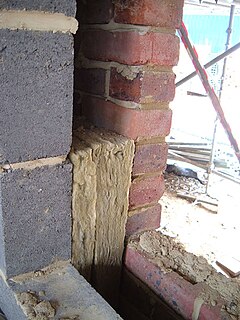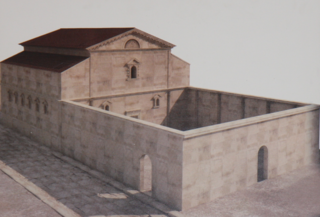
Ancient Roman architecture adopted the external language of classical Greek architecture for the purposes of the ancient Romans, but was different from Greek buildings, becoming a new architectural style. The two styles are often considered one body of classical architecture. Roman architecture flourished in the Roman Republic and even more so under the Empire, when the great majority of surviving buildings were constructed. It used new materials, particularly concrete, and newer technologies such as the arch and the dome to make buildings that were typically strong and well-engineered. Large numbers remain in some form across the empire, sometimes complete and still in use to this day.

Plovdiv is the second-largest city in Bulgaria after Sofia, with a city population of 346,893 as of 2018 and 675,000 in the greater metropolitan area. Plovdiv is the culture capital of Bulgaria. It is an important economic, transport, cultural, and educational center. There is evidence of habitation in Plovdiv dating back to the 6th millennium BCE, when the first Neolithic settlements were established. It has been considered to be one of the oldest cities in the world.

The Baths of Diocletian were public baths in ancient Rome, in what is now Italy. Named after emperor Diocletian and built from 298 AD to 306 AD, they were the largest of the imperial baths. The project was originally commissioned by Maximian upon his return to Rome in the autumn of 298 and was continued after his and Diocletian's abdication under Constantius, father of Constantine.

A cavity wall is a type of wall that has a hollow center. They can be described as consisting of two "skins" separated by a hollow space (cavity). The skins typically are masonry, such as brick or cinder block. Masonry is an absorbent material and therefore slowly draw rainwater or even humidity into the wall. One function of the cavity is to drain water through weep holes at the base of the wall system or above windows. The weep holes allow wind to create an air stream through the cavity that exports evaporated water from the cavity to the outside. Usually, weep holes are created by separating several vertical joints approximately two meters apart at the base of each story. Weep holes are also placed above windows to prevent dry rot of wooden window frames. A cavity wall with masonry as both inner and outer skins is more commonly referred to as a double wythe masonry wall.

The Library of Celsus is an ancient Roman building in Ephesus, Anatolia, now part of Selçuk, Turkey. The building was commissioned in the 110s C.E. by a consul, Gaius Julius Aquila, as a funerary monument for his father, former proconsul of Asia Tiberius Julius Celsus Polemaeanus, and completed during the reign of Hadrian, sometime after Aquila's death. The library is considered an architectural marvel, and is one of the only remaining examples of a library from the Roman Empire. The Library of Celsus was the third-largest library in the Roman world behind only Alexandria and Pergamum, believed to have held around twelve thousand scrolls. Celsus is buried in a crypt beneath the library in a decorated marble sarcophagus.

Plovdiv Roman theatre is one of the world's best-preserved ancient theatres, located in the city center of Plovdiv, Bulgaria. It was constructed in the 90s of the 1st century AD, probably under the rulership of Emperor Domitian. The theatre can host between 5000 and 7000 spectators and it is currently in use.

The Roman Stadium in Plovdiv, Bulgaria, is among the largest and best preserved buildings from the time of the Ancient Rome in the Balkan peninsula. The facility, approximately 240 m (790 ft) m long and 50 m wide, could seat up to 30000 spectators. Today, the northern curved part of the stadium is partially restored and is one of the most recognisable landmarks of the city among the many preserved buildings from Roman times.
The city of Plovdiv is situated in southern Bulgaria. During its long history it has been conquered by numerous peoples: Thracians, Macedon, Romans, Byzantines, Bulgarians, Ottoman Turks which contributed to the city's various historical heritage.

The Curia Julia is the third named Curia, or Senate House, in the ancient city of Rome. It was built in 44 BC, when Julius Caesar replaced Faustus Cornelius Sulla's reconstructed Curia Cornelia, which itself had replaced the Curia Hostilia. Caesar did so to redesign both spaces within the Comitium and the Roman Forum. The alterations within the Comitium reduced the prominence of the Senate and cleared the original space. The work, however, was interrupted by Caesar's assassination at the Theatre of Pompey, where the Senate had been meeting temporarily while the work was completed. The project was eventually finished by Caesar's successor, Augustus Caesar, in 29 BC.

The Odeon of Philippopolis was the house of the city council of citizens of ancient Plovdiv. It was also used as a theatre due to its appropriate structure. The Odeon buildings had four construction periods: from the 2nd century AD when it was initially built to the 4th century AD when it was abandoned. The existence of such a building in ancient Plovdiv is a sign for the importance of Philippopolis as a cultural and political center.

Located in the shadow of Mount Vesuvius, Herculaneum was an ancient Roman town destroyed by volcanic pyroclastic flows in 79 AD. Its ruins are located in the comune of Ercolano, Campania, Italy.

The former Harmanus Bleecker Library is located at the intersection of Washington Avenue and Dove Street in Albany, New York, United States. It is a brick and stone Classical Revival building constructed in the 1920s. In 1996 it was listed on the National Register of Historic Places.

The Small Basilica of Philippopolis is one of Plovdiv's most distinctive landmarks. The basilica is located on Maria Louisa Blvd in the central part of Bulgaria's second-largest city. The ruins of the early Christian church were found during construction works in the area in 1988. The three-nave basilica is an example of the exceptional skill of mosaic builders in ancient Philippopolis.

Philippopolis is one of the ancient names of the city of Plovdiv and is the one by which it was known for the most of its recorded history. The city became one of the largest and most important in region, as shown by its still impressive ancient remains, and was called "the largest and most beautiful of all cities" by Lucian.

The Bishop's Basilica of Philippopolis is a church from the late antique era in Plovdiv, built in the 4th century AD. It is the largest early-Christian temple discovered in Bulgaria and one of the largest from that period on the Balkans. The basilica has three naves with an apse situated at the East end of the central nave. The southern and part of the central nave are revealed. The Bishop's Basilica is one of the most interesting cultural heritage sites in Plovdiv.

The Roman forum of Philippopolis is a rectangular forum (plaza) surrounded by the ruins of several ancient administrative buildings at the center of the city of Plovdiv. It was the center of public, administrative, commercial and religious life in the ancient city. Meetings, discussions, celebrations and state events were held there.

The Synagogue of Philippopolis is an ancient religious building built in ancient Philippopolis, now the city of Plovdiv, in the 3rd century AD. The synagogue is the only ancient Jewish temple found in Bulgaria. Today, only the foundation of the temple on part of the mosaic floor are preserved. The ruins of the ancient temple are located on Maria Luiza blvd.

Eirene residence is an ancient peristyle house with lavish mosaic floors in Plovdiv built in the middle of the 3rd century AD. The excavated area of the residential complex is 668 square meters, of which 160 square meters are colorful mosaics. The remains of the residence are located in the archeological underpass of Tsar Boris III Boulevard and is part of the exhibitions in the TrakArt cultural complex.

The Eastern gate of Philippopolis is one of the three entrances of the ancient city that have been discovered in Plovdiv. The gate was built on the main road to Byzantium and the Bosphorus. Initially constructed in the 2nd century AD during the reign of Hadrian, the gate and the complex around it were completely rebuilt in the 4th century, and partially repaired in the 5th century. The Eastern gate was discovered in the 1970s.

The old town in Plovdiv is an architectural and historical reserve located on three of Plovdiv's hills: Nebet Tepe, Dzhambaz Tepe and Taksim Tepe.
























